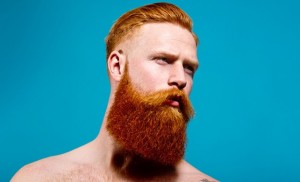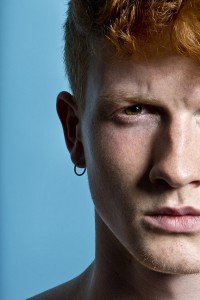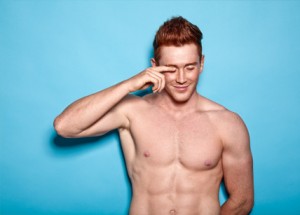Sinéad Baker | Editor-at-Large
It’s rare that a premise as simple as an exhibition full of photos of beautiful men can challenge any of our society’s assumptions, but the RED HOT exhibition by London- based photographer Thomas Knights has put an interesting twist on the usual creative exercise of capturing beautiful people: using only red-headed men as models.
In essence, Knights aims to “rebrand the ginger male stereotype”
For Knights, red-headed men in our culture “are typically portrayed as re-masculated and de-sexualised” and he aims to capture the sense that ginger men can be strong, sexy and desirable, and that the red-headed man can indeed be the hero. In essence, Knights aims to “rebrand the ginger male stereotype”.
Knights has managed to immerse himself in almost every creative enterprise. He has seen success as a singer, music producer and filmmaker who has produced videos for the likes of Marina and The Diamonds, Labrinth and Tony Bennett and has had photos featured in Dazed and Confused, Marie Claire and Vogue Italia. Knights has recently been touring with RED HOT, his first solo exhibition as a photographer.

Knights warns photographers of being taught the ‘right way’: “I don’t believe there is a right way”, and it’s clear that his way has been hugely successful for him. RED HOT has seen a hugely positive response and has been covered by major media outlets from the Guardian and The New York Times to Grazia and Elle Australia. Knights’ appearance on the BBC saw 60 million viewers globally and US TV show host Conan O’Brien made his own “hotter” version of Knight’s video. The exhibition, which has been in London, Amsterdam, Berlin and New York, and plans “to tour the world”, has since seen the release of an anti-bullying calendar and has had a successful Kickstarter campaign to release a coffee table art book: RED HOT 100.
“the fact that I’m ginger is mentioned in every walk in my life… “being a ginger” is still a tolerable snub by supposedly mature adults and children alike.”
What is perhaps most powerful when looking into RED HOT is the experiences of the models themselves. The men, strikingly handsome and undeniably sexy, have faced discrimination simply due to their hair colour. The RED HOT 100, the art book of the RED HOT exhibition, will feature quotes from the models featured, including a testimony from model and Olympic Gold medalist Greg Rutherford who explains that: “the fact that I’m ginger is mentioned in every walk in my life… “being a ginger” is still a tolerable snub by supposedly mature adults and children alike.”
Knights struggled to find models initially as demand for red-headed models and leading men is sparse. RED HOT is in line with the anti-bullying alliance, with the 2014 charity calendar raising over £7,000 for anti-bullying charities, and Knights admits that: “I’d say maybe only 10% of the models could say that they’ve faced no problems. The general consensus is that all of them have faced problems as a direct result of their hair. One of the models was dying his hair blonde for ten years, until eventually sitting up and saying ‘I can’t live like this anymore.’ That he would live that way is absolutely mad. Everyone says they’re surprised that the models could have faced problems due to their appearance, but I think everyone blossoms and comes into their own once they leave school. However, prejudice often doesn’t disappear as we grow, and bullying is still a massive problem for redheads in schools”.
RED HOT trailer from Thomas Knights on Vimeo.
These experiences that some redheads face may seem trivial to those who have never experienced them: they aren’t widely discussed or taken seriously, and can be seen as a joke in wider society, such as the cases where young children have been attacked due to the, supposedly comical, ‘Kick a Ginger Day’.
These experiences that some redheads face may seem trivial to those who have never experienced them and can be seen as a joke in wider society
At least in pop culture, this prejudice is mostly directed towards males. Red-headed females “are presented as sexualised beings, the ‘ultimate woman’, the sexual goal. They are the Jessica Rabbits, the Nicole Kidmans.” Throughout our culture, for Knights, “women are fiery, sexualised beings while males are failed to even be represented properly” but redheaded men “act as comic relief. They’re emasculated and generally unattractive and serve to lighten up the darker themes. They’re quite weak, they’re not even powerful in a bad way. If anything they start off playing up to stereotypes”. Think Ron Weasley in Harry Potter or Fry in Futurama.
Perhaps the lack of leading men with red hair is easily explained: “It’s a gamble for studios to even have a red-headed leading man. It could split the audience”. Yet he maintains that “Hollywood does have a lot to answer for in their representations of red-headed men. I want to see a major red-headed superhero, or a Bond, who is essentially the ultimate man.”

There are signs, thankfully, that things that may be improving. For every idiotic character who’s unattractiveness is a running joke, we’re starting to see stars, such as Homeland’s Damian Lewis and Ed Sheeran, that are considered sex-symbols. To be attracted to a red-headed man can still be quite taboo, but perhaps the success of RED HOT is another sign that things are changing. The web reveals the stories of young red-headed boys, who are being bullied at school due to their hair colour, coming to the exhibition to have their preconceptions changed.
That’s the message of RED HOT – that ginger men aren’t as often depicted in our movies and our films, and that ginger males should take pride in themselves: “If you make the thing you’re bullying about desirable then you sort of defunct the whole argument from their end. So, that was the thinking, making it alpha-male, sexy and heroic, and all these sorts of things. The whole sort of anti-bullying message is actually purposefully put to the back of the mind, and it’s done subconsciously. You go to the exhibition and you see all these hot guys staring down at you from the walls, and your mind is shifted immediately through the imagery, the sex quality, rather than you being bombarded with an anti-bullying message. And I think that was the thinking behind it, keeping it sexy. It’s really intensely sexy, and it’s really intensely hot, and it’s really intensely over the top. And it’s because of this immediacy, that see the amount of hot ginger guys all together at the same time, that it’s quite an overwhelming experience – some people said they didn’t realise you could even get good looking ginger men! Some people are coming from really a far away place, and you get others who have a ginger fetish, who don’t need any convincing, and they absolutely love the whole idea of it from day one. It’s purposefully done in a sort of overt and a quite affronting way, most of them are looking directly into the camera, directly at the viewer, and their look is often quite sexy and confident, almost god-like in pose, and that’s all purposefully done.”

The issue here is not that some gingers have can face discrimination: people are taunted for anything from the clothes they wear to their address – but that this particular form of discrimination is rarely taken seriously and, of course, is perpetuated by popular culture. The fact of the matter is that prejudice is irrational, and humans focus on arbitrary aspects of our appearance, sexuality or nationality to seek out and punish others for. “What people need in life is something to put down, and this is what seems to be the way human nature is, we need something to put down – we need something that we don’t like, and makes us feel better about ourselves. We need something that’s allowed to happen, and this whole anti-ginger thing is sort of allowed and accepted socially. It’s great for people because they’re allowed to do it with a nudge and a smile and a wink and it’s all a laugh and it’s not usually vindictive, at least when you get to adult level. It’s just fun to be able to take the piss out of somebody. But in schools obviously it can be a lot more intense, and a lot more disruptive. It can be a real kind of discrimination and can lead to some awful situations for kids. Humans need this thing that they can put beneath them, to have a form of discrimination that is acceptable socially. ”
Knights explains, “It is the only white ‘other’. In society it is no longer okay to be publicly racist or sexist, so instead we focus on whatever else stands out – here I’m focusing on red hair, freckles, pale skin …it’s sad, and it’s a weird reflection on human nature that we want something to be able to ridicule, and for that to be okay. ”
RED HOT, however, highlights this prejudice and hopes to challenge it in a playful but powerful way. For Knights, RED HOT is important because it’s what he believes in. “People will see it and gain something from it instantly. There’s a uniform concept and there’s the striking blue background. You receive something instantly from the project. It’s important as a photographer to work on something that speaks to you, others will see that love in whatever you’re working on”.
RED HOT: LONDON from Thomas Knights on Vimeo.
You can find out more about the Red Hot Exhibition at www.redhot100.com







